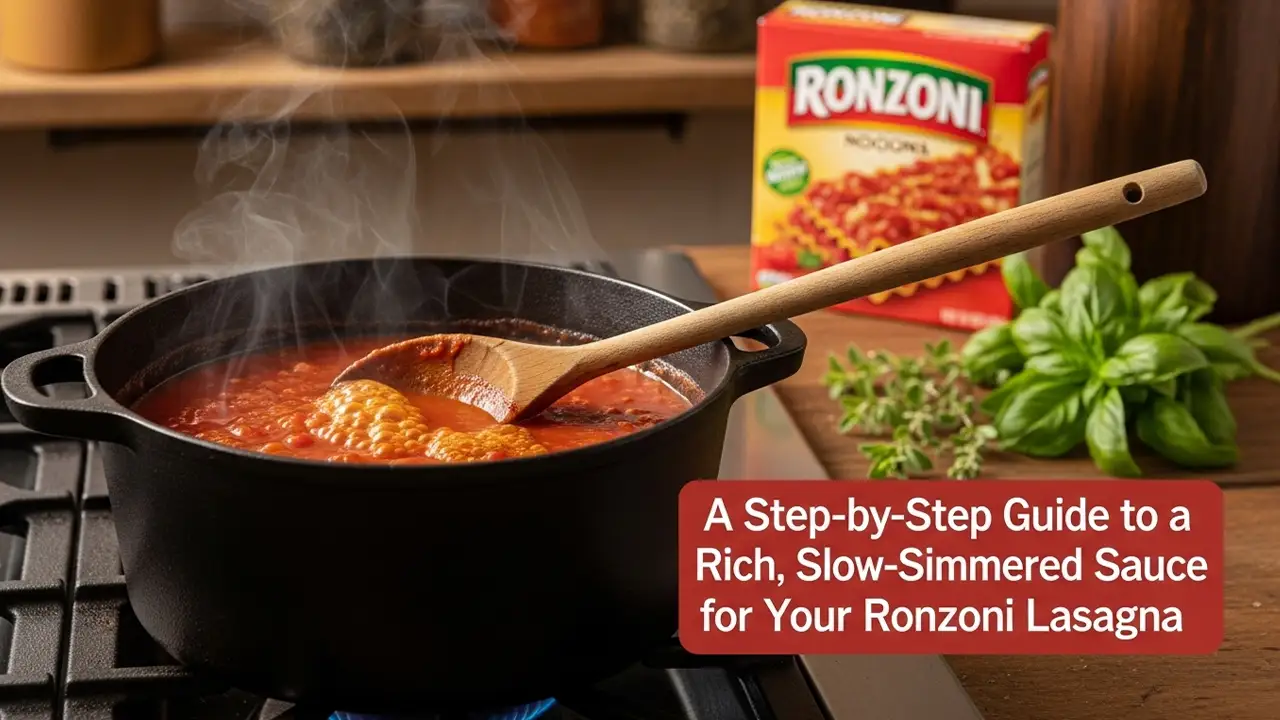
Can you smell that? It’s the rich, unmistakable aroma of a real Sunday sauce simmering on the stove for hours, filling the entire house with warmth and promise. This, my friend, is the soul of Italian-American cooking. Yet, in our rush, we often settle for quick sauces that taste incomplete. We know the disappointment of a thin, watery sauce, the sharp acidic bite, the one-dimensional flavor that just coats the pasta. This guide is the antidote. This is A Step-by-Step Guide to a Rich, Slow-Simmered Sauce for Your Ronzoni Lasagna.
Mastering this homemade lasagna sauce is the single most important step to elevate your lasagna from good to truly unforgettable. This is the one.
This guide is my promise to you. It’s a blueprint for a rich tomato sauce that is thick, velvety, and deeply savory. It’s the kind of sauce that tells a story, a foundation so flawless that it makes every layer of your lasagna sing. So, grab your heaviest pot. Let’s create the heart of your masterpiece.
My Quest for Perfection: A “Sunday Gravy” Love Story
My journey to this sauce began with a simple realization: in my Nonna’s kitchen, the sauce wasn’t just a component; it was the main event. The lasagna and the pasta were simply vessels for delivering that incredible Italian red gravy. For years, I tried to replicate its flavor with quick recipes, but I always failed. It lacked the depth and the feeling of a sauce that had been shown love and, most importantly, time.
This frustration sent me on a quest to understand the soul of the classic Sunday sauce. I learned it was a tradition brought from Southern Italy, a way to use simple ingredients to create something luxurious through the magic of time. It’s a testament to the Italian philosophy of pazienza—patience.
My lightbulb moment was when I stopped rushing. I realized the secret wasn’t adding more ingredients, but giving the existing ones the proper time and technique to shine. The slow, gentle simmer is not just a step; it is the entire point. It’s how you transform simple ingredients into a complex, harmonious sauce.
The 7 Elements of a Perfect Homemade Lasagna Sauce
A perfect sauce isn’t luck; it’s the mastery of seven key elements. Understand and execute each one, and you will achieve a flawless Ronzoni lasagna sauce recipe every time.
Element 1: Why Use San Marzano Tomatoes in a Rich Tomato Sauce?
The foundation of any great red sauce is the tomato. Using high-quality, canned San Marzano or San Marzano-style tomatoes is highly recommended. These tomatoes are less acidic and have a sweeter, deeper flavor, creating a naturally superior base.
Element 2: The Aromatic Base – Soffritto Secrets for Flavor
This is where you build your first layer of deep flavor. A classic Italian soffritto—a mixture of finely diced onion, carrot, and celery—sautéed slowly provides a sweet, earthy foundation that simple garlic and onion cannot replicate.
Element 3: The Fat Foundation – How to Build Richness
Fat equals flavor. Start with a good quality extra virgin olive oil. For an even deeper, more savory sauce, begin by rendering finely diced pancetta or browning Italian sausage in the pot. The rendered fat creates an incredibly flavorful base for your aromatics.
Element 4: The Simmering Science – Why Time is Your Best Friend
This is the most critical element for any slow-cook pasta sauce. A low, slow simmer for a minimum of 3-4 hours does two magical things: it melds the flavors into something complex, and it slowly evaporates water, naturally thickening the sauce.
Element 5: The Balancing Act – Seasoning Your Italian Red Gravy
A great sauce is perfectly balanced. Season with salt and pepper at multiple stages. A splash of dry red wine adds depth, while a pinch of sugar or the sweetness from the carrots in your soffritto will counteract any overly acidic taste from the tomatoes.
Element 6: Strategic Herb Infusion
Use herbs strategically. Add dried herbs (like oregano and bay leaves) early in the simmer because they release their flavor slowly. Add fresh, delicate herbs (like basil) at the very end to preserve their bright, aromatic oils.
Element 7: The Finisher – The Final Touch for a Flavorful Ragu
Just before serving, a final touch can elevate your sauce. Stirring in a knob of cold butter adds a beautiful, velvety sheen. Adding a Parmesan cheese rind to the pot during the last hour imparts an incredible, savory umami depth.
Read 7 Essential Elements for Perfect Ronzoni Lasagna
How to Make a Rich, Slow-Simmered Sauce: The Step-by-Step Method
Now, let’s put all 7 elements into practice. Approach this with a calm, deliberate focus.
- Build the Flavor Base (Elements 2 & 3): Heat olive oil in a large, heavy-bottomed pot over medium heat. If using meat, add it now and cook until browned and the fat has rendered. Remove the meat. Add the diced onion, carrot, and celery. Sauté slowly for 10-15 minutes, until very soft and sweet. Add the minced garlic and cook for one more minute until fragrant.
- Deglaze and Deepen Flavor (Element 5): If using, pour in the red wine to deglaze the pan, scraping up any browned bits. Let it bubble and reduce by half.
- Combine Ingredients (Elements 1 & 6): Stir in the tomato paste and cook for a minute. Add the crushed tomatoes, water or stock, the cooked meat, and your dried herbs (bay leaves, oregano).
- Simmer Low and Slow (Element 4): Bring the sauce to a gentle bubble, then immediately reduce the heat to the absolute lowest setting. Cover the pot with the lid slightly ajar. Let this simmered spaghetti sauce go for a minimum of 3 hours, stirring every 30-40 minutes.
- Finish the Sauce (Element 7): In the last 15 minutes of cooking, remove the bay leaves. Stir in the chopped fresh basil and the butter, if using. Taste and adjust the final seasoning.
Your Slow-Cook Pasta Sauce Troubleshooting Guide
Even with a perfect blueprint, issues can arise. This guide helps you diagnose which element might have failed.
| The Problem | The Likely Cause(s) (Element Failure) | The Foolproof Solution |
| My sauce tastes bland or flat. | Failure in Element 2 or 5. (Aromatics were rushed, or sauce was under-seasoned). | Sauté the soffritto slowly until truly soft and sweet. Season with salt at multiple stages, not just at the end. |
| My sauce is too watery or thin. | Failure in Element 4. (Simmering time was too short). | Continue to simmer the sauce with the lid slightly ajar to allow more water to evaporate and the rich tomato sauce to naturally thicken. |
| My sauce tastes too acidic. | Failure in Element 1 or 5. (Naturally acidic tomatoes, or imbalance). | Add a pinch of sugar or a peeled carrot to the sauce as it simmers to counteract the acidity. Remove the carrot before serving. |
| My sauce is bitter. | Failure in Element 2. (The garlic was burned). | Sauté garlic only for about one minute until fragrant. Never let it brown; burnt garlic is intensely bitter. |
| The sauce has a greasy texture. | Failure in Element 3. (The fat from the meat was not drained properly). | Drain off almost all of the rendered fat from any ground meat or sausage before adding it to your homemade lasagna sauce. |
Frequently Asked Questions (FAQ)
- Can I use fresh tomatoes instead of canned?
Yes, but it’s a different process. You will need to blanch, peel, and seed ripe plum tomatoes first. Canned San Marzano tomatoes provide excellent, consistent results with less effort for this ronzoni lasagna sauce recipe. - How long is too long to simmer the sauce?
It’s hard to over-simmer a sauce like this. It will continue to deepen in flavor for up to 5-6 hours. Just ensure the heat is very low and you stir it occasionally. - Can I make this sauce in a slow cooker?
Absolutely. After you complete step 2 on the stovetop, transfer everything to a slow cooker and cook on low for 6-8 hours for a perfect slow-cook pasta sauce. - How do I store leftover sauce?
Let the sauce cool completely. It stores beautifully in an airtight container in the refrigerator for up to a week, or in the freezer for up to 6 months. - What can I do with leftover sauce?
This sauce is incredibly versatile! It is perfect for my Ultimate Baked Ziti, as a base for Chicken Parmigiana, or on pizza.
Recipe Summary: The Soul of Your Lasagna (and Other Dishes!)
This rich, slow-simmered sauce is thick, velvety, and packed with layers of deep, complex flavor. The low-and-slow simmering process melds the sweetness of the aromatic vegetables, the richness of the tomatoes, and the savory notes of the herbs into an unforgettable foundation. Its thick consistency is engineered to be the best marinara for lasagna, hydrating the pasta perfectly without ever creating a watery result.
Ready to build your masterpiece? Read my complete, step-by-step Ultimate Ronzoni Lasagna Recipe!
Nutritional Profile (Approximate Values Per ½ Cup Serving of Sauce)
- Calories: 95 kcal
- Protein: 4g
- Fat: 5g
- Carbohydrates: 8g
- Fiber: 2g
- Sugar: 5g
